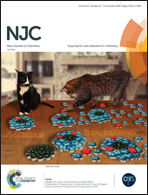Fabrication of a self-assembled supramolecular fluorescent nanosensor from functional graphene oxide and its application for the detection of Al3+†
Abstract
In this paper, an excellent water-soluble platform derived from a β-cyclodextrin derivative and graphene oxide was synthesized and characterized. Moreover, by a supramolecular host–guest self-assembly interaction between the organic molecule and the water-soluble platform, an interesting supramolecular system was fabricated successfully. By fluorescence experiments toward several metal ions, a higher response toward Al3+ than other commonly coexistent metal ions in absolute water media (pH = 7.2) was shown. Meanwhile, a large binding constant (3.89 × 1012 M−1) between them was calculated by fluorescence titration experiments. In addition, fluorescence imaging in living cells was studied systemically, which exhibited a high fluorescence sensing activity toward Al3+. This study provides the first detailed supramolecular host–guest self-assembled nanosensor from graphene oxide and β-cyclodextrin derivatives. Its water-solubility and excellent sensing activity effectively enhanced the application value of the fluorescent nanosensor for tracking and detecting Al3+ in the environment and in organisms.



 Please wait while we load your content...
Please wait while we load your content...